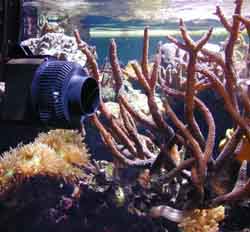Aquarium Water movement is crucial to your saltwater aquarium. Your fish and corals and other reef inhabitants are used to constant water movement.
It is important for:
- growth
- waste removal
- and the health of your fish
In nature, water current brings corals, clams and other invertebrates food, oxygen, nutrients, and movement that they need to grow. In your aquarium, water movement will do this task.

Another important aspect of water movement is the waste removal of products from the corals and other animals in your aquarium that do not move freely.
Mucus or saliva like compound that coral produce must be swept away before they suffer from other problems such us infection or suffocation.
And one of the basic aspects that affects your saltwater fishes’ health is the gas exchange. It provides vital circulation that helps introduce oxygen into the water and releases harmful gasses like carbon dioxide.
Water movement also helps your fish to burn excess fat from many commercial fish foods. The movement among fish will increase due to the water current.
What are the effective ways to simulate the aquarium water movement?
To learn that, first you must understand the three main types of water movement.
In their natural habitat, different types of water movement and different animals have gotten used to these types of environments. So to be successful with these animals, it is important to research what area of the reef they lived in.
This will help you figure out the type and intensity of aquarium water movement you will need to provide.
- Laminar flow is the most common in the aquarium and simply means that the water is moving steadily and in only one direction. It is most often produced by powerheads. In the ocean, this type is found in deeper areas of the reef.
- Surge is similar to laminar flow, only stronger, for a shorter duration, and followed by a weaker reverse flow. You think of waves when talking about water movement in the ocean right? Waves are created by winds and this best illustrates surge. This back and forth type of aquarium water movement is very beneficial to corals in your tank.
- Turbulence is the random swirling and flow of water in all directions. This happens when currents collide with each other. Of the three types, turbulence is the most desirable and the most difficult to replicate.
Going back to the question “what are the effective ways to simulate the aquarium water movement?”, well you can use several means.
Powerheads

Majority of the hobbyists use either external pumps (outside the aquarium) or internal pumps, called powerheads. They come in all sizes and flow rates.
Most powerheads are relatively inexpensive and produce only laminar flow.
Invertebrates may get damaged if the flow is aimed directly at them. So if you choose to use powerheads, remember not to direct the flow to your invertebrates.
What you can actually do is to direct the flow to a dead area in your tank to reduce detritus buildup. You can also create multi-directional flow with a powerhead by adding PVC pipe and fittings to the outflow.
Oscillating Powerheads
Oscillating powerheads rotate within the aquarium and direct water over a wider area. If you have a couple of these installed in your tank, you can create a turbulence flow which is similar to the one found on a reef.
Wavemakers
No products found. are also available to immitate the water flow in the ocean to your aquarium. If you have powerheads at different location in your tank, the wavemaker will alternate the power to these powerheads, and copies the natural ocean currents.
No products found.
No products found.
If you have a saltwater aquarium aquarium with corals and do not have enough water movement for your corals, try investing a wavemaker into your system, and watch the improvement in your coral growth.
Water Flow Diverter
A diverter is another means of creating an aquarium water movement. It is installed on the return of your main filtration and directs incoming water to two alternating outputs, creating the beneficial aquarium water movement.
I hope that after reading this article, it will help you decide on an aquarium water movement system that will make your saltwater aquarium a success.
Return from Aquarium Water Movement to Main Page
* Disclaimer: Saltwater-Aquarium-Online-Guide.com is a participant in the Amazon Services LLC Associates Program, an affiliate advertising program designed to provide a means for sites to earn advertising fees by advertising and linking to amazon.com, amazon.co.uk, amazon.ca. Amazon and the Amazon logo are trademarks of Amazon.com, Inc. or its affiliates. We may receive a small commission if you click on one of our links and make a purchase. Thank you for supporting Saltwater-Aquarium-Online-Guide.com and helping me make it the best site possible!
Last update on 2024-03-17 / Affiliate links / Images from Amazon Product Advertising API


